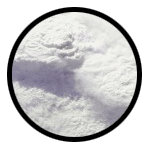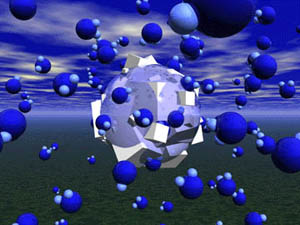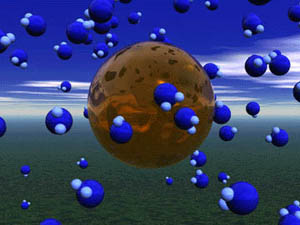|  Clouds are
visible collections of small particles of water or ice, or both, suspended in the
atmosphere. They are one of the most obvious and influential features of Earth's
climate system. They are also one of its most variable components. The natural
diversity and variability of clouds has intrigued and challenged researchers for
centuries. Clouds are
visible collections of small particles of water or ice, or both, suspended in the
atmosphere. They are one of the most obvious and influential features of Earth's
climate system. They are also one of its most variable components. The natural
diversity and variability of clouds has intrigued and challenged researchers for
centuries.
How Do Clouds Form?
In order to form, clouds require the presence of water vapor and aerosols (tiny
solid or liquid particles suspended in the atmosphere)-both are found abundantly
in Earth's atmosphere. Water vapor, or water in its gaseous state, is
transferred from the surface to the atmosphere primarily via either evaporation
or "evapotranspiration," (the process by which water is evaporated from the tiny
openings on the leaves of plants during respiration).


Figures 1a and 1b: Hygroscopic nuclei (1a) consist of particles such as
sea salt and common table salt which have an affinity (attraction) for
water. Water vapor condenses on these particles when the relative
humidity it considerably less than 100 percent. On humid days, you may
find it difficult to pour salt from the shaker because water vapor has
condensed on the salt crystals, sticking them together. Hydrophobic
nuclei (1b) consist of particles such as oils and Teflon. These nuclei
resist condensation even when the relative humidity is greater than 100
percent.
As air currents rise, taking water vapor molecules along with them, they tend to
cool. This vertical motion of air currents helps clouds form, by exposing its
water vapor to both cooler temperatures and cloud condensation nuclei
(CCN-aerosol particles up to one-millionth of a meter in size) also suspended in
the atmosphere. There are many types of CCN, ranging from sea salt to windblown
dust to industrial pollution. These nuclei are hygroscopic ("water-attracting")
while others (oils, Teflon) are hydrophobic ("water-repelling") (Figures 1a and
1b). Since hygroscopic nuclei have an affinity for water, they act as "seeds" to
accelerate the condensation process to convert water from its gaseous to its
liquid phase.
In the presence of CCN, clouds form in either of two ways: (1) when a region of
atmosphere cools to the temperature at which water vapor condenses into water
droplets or is deposited into ice crystals; or (2) when sufficient amounts of
water vapor are added to a given region of atmosphere, yielding the formation of
water droplets (condensation) or ice crystals (deposition).
next: Clouds and Climate Change
|
|
by Steve Graham
May 13, 1999

- Changing Global Cloudiness
- How do Clouds Form?
- Clouds and Climate Change
- Surface-Based and Satellite Cloud Observations
- Terra and Cloud Observations
|


